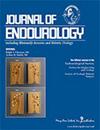Amy M Reed, Yizhou Li, Jumanh Atoum, Ayberk Acar, Callahan Henry, Jie Ying Wu, Nicholas Kavoussi
求助PDF
{"title":"在内窥镜结石手术中评估光学跟踪以区分外科医生的经验。","authors":"Amy M Reed, Yizhou Li, Jumanh Atoum, Ayberk Acar, Callahan Henry, Jie Ying Wu, Nicholas Kavoussi","doi":"10.1089/end.2024.0246","DOIUrl":null,"url":null,"abstract":"<p><p><b><i>Introduction and Objectives:</i></b> Optical tracking (OT) has shown potential in assessing surgical skill but has yet to be evaluated for endoscopic urologic surgery. We sought to evaluate the potential for OT to distinguish expert and trainee surgeons during flexible ureteroscopy (fURS) for kidney stone treatment in both simulated and live surgical settings. <b><i>Methods:</i></b> We performed OT analysis of six surgeons performing stone localization during fURS in two settings. In the first setting, surgeons were tasked with fiducial localization in three separate kidney phantoms during fURS. In the second setting, surgeons performed stone localization via fURS in five separate patients. Surgeons were categorized as \"expert\" (<i>n</i> = 3, endourologist, average case volume of >100 fURS per year) or trainee (<i>n</i> = 3, trainee, <100 fURS per year). OT metrics were recorded for both settings using the Microsoft HoloLens 2© as the surgeons viewed the surgical monitor during fURS. Standard OT metrics of experts and trainees were compared, and included: area of eye gaze movement, gaze distance traveled, number of gaze fixation points, percentage of gaze fixation dwell time, and number of saccades. <b><i>Results:</i></b> In the simulated setting, the average time for stone localization was greater for trainees compared to experts (318 seconds <i>vs</i> 52 seconds, <i>p</i> < 0.01). Additionally, the mean area of eye gaze movements with area of interest (AOI) was greater for trainees compared to experts (1430 cm<sup>2</sup> <i>vs</i> 1060 cm<sup>2</sup>, <i>p</i> < 0.01). The total gaze distance traveled was also greater for trainees compared to experts (1480 cm <i>vs</i> 730 cm, <i>p</i> < 0.01). In the live surgical setting, average time for stone localization was similar for trainees and experts (74 seconds <i>vs</i> 51 seconds, <i>p</i> = 0.05). The total area of eye gaze movements in AOI was greater for trainees compared to experts (700 cm<sup>2</sup> <i>vs</i> 30 cm<sup>2</sup>, <i>p</i> < 0.01). Additionally, the total gaze distance traveled was greater for trainees compared to experts (14,000 cm <i>vs</i> 680 cm, <i>p</i> < 0.01). This suggests more varied and less point specific concentration on the surgical screen by trainees. There was no difference in percentage of gaze fixation dwell time and number of saccades between experts and trainees in either setting. <b><i>Conclusions:</i></b> OT analysis can objectively distinguish surgical experience between experts and trainee surgeons performing fURS in both simulated and live surgical settings. These findings may play a role in future surgical training and skills assessment.</p>","PeriodicalId":15723,"journal":{"name":"Journal of endourology","volume":" ","pages":"1421-1426"},"PeriodicalIF":2.9000,"publicationDate":"2024-12-01","publicationTypes":"Journal Article","fieldsOfStudy":null,"isOpenAccess":false,"openAccessPdf":"","citationCount":"0","resultStr":"{\"title\":\"Evaluation of Optical Tracking to Distinguish Surgeon Experience During Endoscopic Stone Surgery.\",\"authors\":\"Amy M Reed, Yizhou Li, Jumanh Atoum, Ayberk Acar, Callahan Henry, Jie Ying Wu, Nicholas Kavoussi\",\"doi\":\"10.1089/end.2024.0246\",\"DOIUrl\":null,\"url\":null,\"abstract\":\"<p><p><b><i>Introduction and Objectives:</i></b> Optical tracking (OT) has shown potential in assessing surgical skill but has yet to be evaluated for endoscopic urologic surgery. We sought to evaluate the potential for OT to distinguish expert and trainee surgeons during flexible ureteroscopy (fURS) for kidney stone treatment in both simulated and live surgical settings. <b><i>Methods:</i></b> We performed OT analysis of six surgeons performing stone localization during fURS in two settings. In the first setting, surgeons were tasked with fiducial localization in three separate kidney phantoms during fURS. In the second setting, surgeons performed stone localization via fURS in five separate patients. Surgeons were categorized as \\\"expert\\\" (<i>n</i> = 3, endourologist, average case volume of >100 fURS per year) or trainee (<i>n</i> = 3, trainee, <100 fURS per year). OT metrics were recorded for both settings using the Microsoft HoloLens 2© as the surgeons viewed the surgical monitor during fURS. Standard OT metrics of experts and trainees were compared, and included: area of eye gaze movement, gaze distance traveled, number of gaze fixation points, percentage of gaze fixation dwell time, and number of saccades. <b><i>Results:</i></b> In the simulated setting, the average time for stone localization was greater for trainees compared to experts (318 seconds <i>vs</i> 52 seconds, <i>p</i> < 0.01). Additionally, the mean area of eye gaze movements with area of interest (AOI) was greater for trainees compared to experts (1430 cm<sup>2</sup> <i>vs</i> 1060 cm<sup>2</sup>, <i>p</i> < 0.01). The total gaze distance traveled was also greater for trainees compared to experts (1480 cm <i>vs</i> 730 cm, <i>p</i> < 0.01). In the live surgical setting, average time for stone localization was similar for trainees and experts (74 seconds <i>vs</i> 51 seconds, <i>p</i> = 0.05). The total area of eye gaze movements in AOI was greater for trainees compared to experts (700 cm<sup>2</sup> <i>vs</i> 30 cm<sup>2</sup>, <i>p</i> < 0.01). Additionally, the total gaze distance traveled was greater for trainees compared to experts (14,000 cm <i>vs</i> 680 cm, <i>p</i> < 0.01). This suggests more varied and less point specific concentration on the surgical screen by trainees. There was no difference in percentage of gaze fixation dwell time and number of saccades between experts and trainees in either setting. <b><i>Conclusions:</i></b> OT analysis can objectively distinguish surgical experience between experts and trainee surgeons performing fURS in both simulated and live surgical settings. These findings may play a role in future surgical training and skills assessment.</p>\",\"PeriodicalId\":15723,\"journal\":{\"name\":\"Journal of endourology\",\"volume\":\" \",\"pages\":\"1421-1426\"},\"PeriodicalIF\":2.9000,\"publicationDate\":\"2024-12-01\",\"publicationTypes\":\"Journal Article\",\"fieldsOfStudy\":null,\"isOpenAccess\":false,\"openAccessPdf\":\"\",\"citationCount\":\"0\",\"resultStr\":null,\"platform\":\"Semanticscholar\",\"paperid\":null,\"PeriodicalName\":\"Journal of endourology\",\"FirstCategoryId\":\"3\",\"ListUrlMain\":\"https://doi.org/10.1089/end.2024.0246\",\"RegionNum\":2,\"RegionCategory\":\"医学\",\"ArticlePicture\":[],\"TitleCN\":null,\"AbstractTextCN\":null,\"PMCID\":null,\"EPubDate\":\"2024/10/10 0:00:00\",\"PubModel\":\"Epub\",\"JCR\":\"Q1\",\"JCRName\":\"UROLOGY & NEPHROLOGY\",\"Score\":null,\"Total\":0}","platform":"Semanticscholar","paperid":null,"PeriodicalName":"Journal of endourology","FirstCategoryId":"3","ListUrlMain":"https://doi.org/10.1089/end.2024.0246","RegionNum":2,"RegionCategory":"医学","ArticlePicture":[],"TitleCN":null,"AbstractTextCN":null,"PMCID":null,"EPubDate":"2024/10/10 0:00:00","PubModel":"Epub","JCR":"Q1","JCRName":"UROLOGY & NEPHROLOGY","Score":null,"Total":0}
引用次数: 0
引用
批量引用

 求助内容:
求助内容: 应助结果提醒方式:
应助结果提醒方式:


